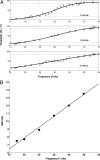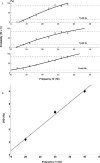Weber's law in decision making: integrating behavioral data in humans with a neurophysiological model
- PMID: 17942714
- PMCID: PMC6673035
- DOI: 10.1523/JNEUROSCI.1072-07.2007
Weber's law in decision making: integrating behavioral data in humans with a neurophysiological model
Abstract
Recent single-cell studies in monkeys (Romo et al., 2004) show that the activity of neurons in the ventral premotor cortex covaries with the animal's decisions in a perceptual comparison task regarding the frequency of vibrotactile events. The firing rate response of these neurons was dependent only on the frequency differences between the two applied vibrations, the sign of that difference being the determining factor for correct task performance. We present a biophysically realistic neurodynamical model that can account for the most relevant characteristics of this decision-making-related neural activity. One of the nontrivial predictions of this model is that Weber's law will underlie the perceptual discrimination behavior. We confirmed this prediction in behavioral tests of vibrotactile discrimination in humans and propose a computational explanation of perceptual discrimination that accounts naturally for the emergence of Weber's law. We conclude that the neurodynamical mechanisms and computational principles underlying the decision-making processes in this perceptual discrimination task are consistent with a fluctuation-driven scenario in a multistable regime.
Figures







Similar articles
-
Decision-making and Weber's law: a neurophysiological model.Eur J Neurosci. 2006 Aug;24(3):901-16. doi: 10.1111/j.1460-9568.2006.04940.x. Eur J Neurosci. 2006. PMID: 16930418
-
Weber's law implies neural discharge more regular than a Poisson process.Eur J Neurosci. 2010 Mar;31(6):1006-18. doi: 10.1111/j.1460-9568.2010.07145.x. Epub 2010 Mar 8. Eur J Neurosci. 2010. PMID: 20377615
-
The neural basis for violations of Weber's law in self-motion perception.Proc Natl Acad Sci U S A. 2021 Sep 7;118(36):e2025061118. doi: 10.1073/pnas.2025061118. Proc Natl Acad Sci U S A. 2021. PMID: 34475203 Free PMC article.
-
Scale (in)variance in a unified diffusion model of decision making and timing.Psychol Rev. 2016 Mar;123(2):151-81. doi: 10.1037/rev0000014. Epub 2015 Oct 12. Psychol Rev. 2016. PMID: 26461957 Review.
-
Reward-dependent learning in neuronal networks for planning and decision making.Prog Brain Res. 2000;126:217-29. doi: 10.1016/S0079-6123(00)26016-0. Prog Brain Res. 2000. PMID: 11105649 Review.
Cited by
-
The rodent medial prefrontal cortex and associated circuits in orchestrating adaptive behavior under variable demands.Neurosci Biobehav Rev. 2022 Apr;135:104569. doi: 10.1016/j.neubiorev.2022.104569. Epub 2022 Feb 4. Neurosci Biobehav Rev. 2022. PMID: 35131398 Free PMC article. Review.
-
Dynamic effective connectivity of inter-areal brain circuits.PLoS Comput Biol. 2012;8(3):e1002438. doi: 10.1371/journal.pcbi.1002438. Epub 2012 Mar 22. PLoS Comput Biol. 2012. PMID: 22457614 Free PMC article.
-
Prediction of Decisions from Noise in the Brain before the Evidence is Provided.Front Neurosci. 2011 Mar 17;5:33. doi: 10.3389/fnins.2011.00033. eCollection 2011. Front Neurosci. 2011. PMID: 21441998 Free PMC article.
-
Effect of the land area elevation on the collective choice in ants.Sci Rep. 2017 Aug 18;7(1):8745. doi: 10.1038/s41598-017-08592-9. Sci Rep. 2017. PMID: 28821811 Free PMC article.
-
The Brain Connectivity Workshops: moving the frontiers of computational systems neuroscience.Neuroimage. 2008 Aug 1;42(1):1-9. doi: 10.1016/j.neuroimage.2008.04.167. Epub 2008 Apr 20. Neuroimage. 2008. PMID: 18511300 Free PMC article.
References
-
- Abeles A. New York: Cambridge UP; 1991. Corticonics.
-
- Amit D, Brunel N. Model of global spontaneous activity and local structured activity during delay periods in the cerebral cortex. Cereb Cortex. 1997;7:237–252. - PubMed
-
- Brody C, Romo R, Kepecs A. Basic mechanisms for graded persistent activity: discrete attractors, continuous attractors, and dynamic representations. Curr Opin Neurobiol. 2003;13:204–211. - PubMed
-
- Brown E, Heathcote A. Indeterminacy in brain and behavior. Annu Rev Psychol. 2005;56:25–56. - PubMed
-
- Brunel N, Wang X. Effects of neuromodulation in a cortical networks model of object working memory dominated by recurrent inhibition. J Comp Neurosci. 2001;11:63–85. - PubMed
Publication types
MeSH terms
LinkOut - more resources
Full Text Sources
